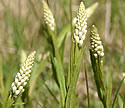Polygala senega (Seneca Snakeroot)
| Also known as: | Mountain Flax, Rattlesnake Snakeroot |
|---|---|
| Genus: | Polygala |
| Family: | Polygalaceae (Milkwort) |
| Life cycle: | perennial |
| Origin: | native |
| Habitat: | part shade, sun; sandy or rocky soil; prairies, stream banks |
| Bloom season: | May - July |
| Plant height: | 10 to 18 inches |
| Wetland Indicator Status: | GP: FACU MW: FACU NCNE: FACU |
| MN county distribution (click map to enlarge): |  |
| National distribution (click map to enlarge): |  |
Pick an image for a larger view. See the glossary for icon descriptions.
Detailed Information
Flower: 


![[photo of flowers]](/udata/r9ndp23q/white/seneca-snakeroot_0523_161022-t.jpg) Spike-like raceme, usually densely arranged, up to about 1½ inches (to 4 cm) long at the tip of the stem. Flowers are short-stalked, white to greenish-white, about 1/6 inch (2 to 4 mm) long with 2 spreading, oval to nearly round, petal-like sepals flanking 3 petals rolled into a central column with a white-fringed, greenish crest. Flowers bloom from the bottom of the spike up.
Spike-like raceme, usually densely arranged, up to about 1½ inches (to 4 cm) long at the tip of the stem. Flowers are short-stalked, white to greenish-white, about 1/6 inch (2 to 4 mm) long with 2 spreading, oval to nearly round, petal-like sepals flanking 3 petals rolled into a central column with a white-fringed, greenish crest. Flowers bloom from the bottom of the spike up.
Leaves and stem: 

![[photo of leaves]](/udata/r9ndp23q/white/seneca-snakeroot_0523_161134-t.jpg) Leaves are alternate, 1 to 3+ inches (to 8 cm) long, 1/3 to 1 1/3 inch (8 to 35 mm) wide, linear to lance-elliptic, widest at or below the middle, toothless, hairless or minutely hairy, blunt or pointed at the tip, tapering at the base, stalkless or sometimes short-stalked. The lowest leaves may be significantly reduced in size and the uppermost leaves are often largest. Stems are usually unbranched and multiple from the base, erect to ascending, hairless or minutely hairy, green to purplish.
Leaves are alternate, 1 to 3+ inches (to 8 cm) long, 1/3 to 1 1/3 inch (8 to 35 mm) wide, linear to lance-elliptic, widest at or below the middle, toothless, hairless or minutely hairy, blunt or pointed at the tip, tapering at the base, stalkless or sometimes short-stalked. The lowest leaves may be significantly reduced in size and the uppermost leaves are often largest. Stems are usually unbranched and multiple from the base, erect to ascending, hairless or minutely hairy, green to purplish.
Fruit: 
![[photo of fruit]](/udata/r9ndp23q/white/seneca-snakeroot_0703_163844-t.jpg) Fruit is a nearly round, slightly flattened, 2-seeded capsule. Seeds are 2 to 3.5 mm long, sparsely hairy, with a 2-lobed appendage that is about as long as or longer than the seed.
Fruit is a nearly round, slightly flattened, 2-seeded capsule. Seeds are 2 to 3.5 mm long, sparsely hairy, with a 2-lobed appendage that is about as long as or longer than the seed.
Notes:
Seneca Snakeroot is found in about half of Minnesota, in a band from Kittson County in the northwest corner down to Houston County in the southeast, absent in the northeast and southwest corners of the state. It frequents open grasslands and woodland openings. The flower spike is similar to the related Whorled Milkwort (P. verticillata) but the latter has leaves whorled in 4s or 5s and usually branches frequently. It is also very similar to White Milkwort (Polygala alba), which is not present in MN but is just to our west and south on the Great Plains, has flower clusters up to 3 inches long, leaves are rarely more than 1 inch long, and the lowest 1 or 2 leaf nodes usually have whorled leaves. Note that several references state P. senega leaves often appear minutely toothed, but we have not observed this in Minnesota populations.
Native Plant Nurseries, Restoration and Landscaping Services ↓
More photos
Photos by K. Chayka taken in Pope and Ramsey counties. Photos by Peter M. Dziuk taken in Blue Earth and Pope counties.
Comments
Have you seen this plant in Minnesota, or have any other comments about it?
on: 2011-06-12 08:37:12
Anybody out there know where to find a stand of Seneca Snakeroot? I would like to establish it in my prairie garden. The seed is hard to find commercially and I have had little luck in growing it from purchased seed. I would like to see it in the wild and find a seed collection site.
on: 2011-06-12 15:26:04
While we do encourage people to go out and explore, I just want to mention that before collecting any seed from any land that is not your own, get permission from the landowner. Collecting anything from public land is not generally permitted, though.
on: 2020-06-01 16:37:53
Finally, I figured it out! Thank goodness for your site. We were walking and spied this and small white lady slippers! Quite a few beauties, also of note, for me at least, were yellow star grass. Hoary puccoon. I think I am correct it's hoary, I did look it up because I thought it may be hairy, but pretty sure I'm correct. Also, we were in Dakota County, Murphy Hanrahan , we found one showy orchis, it was pretty surrounded by all the buckthorn you can imagine! Horrible, young & old bushes.
on: 2020-06-19 15:39:35
Photographed it on the side of a rural farm road in Marshall County on June 18, 2020







 Seneca Snakeroot plants
Seneca Snakeroot plants Seneca Snakeroot in open prairie
Seneca Snakeroot in open prairie Seneca Snakeroot in shady woods
Seneca Snakeroot in shady woods